 3 Beauties 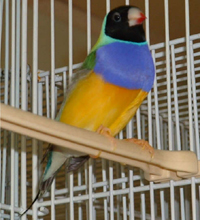 BH male beauty 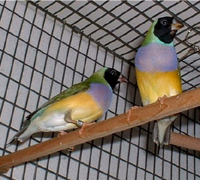 BHPB Females 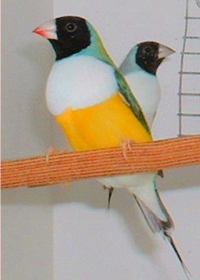 BHWB Male  Gouldian upclose 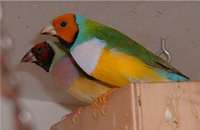 Orange Head Pair  Red Head Female  The 4 Lovlies 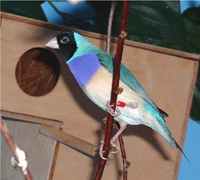 Blues Nest |
"Lady Gouldian
Finch"
excerpt from workshop given by Jean Tarr
John Gould named this finch after his wife who illustrated each bird species as he catalogued it. Natural habitat only in Northern Australia in open tropical woodlands. In 1960, Australia closed its borders to exporting its wild life with an aim to protecting it.
Unfortunately this has not been the case. The beautiful Lady Gouldian
is now listed as endangered. There are less than 2500 birds in existence
with these being in poor condition and producing on average 1.5 youngsters
per pair per breeding season. There is an ongoing decline of greater than
20% every 5 years.
Habitat destruction has been blamed for the decline in numbers.
1. increase in cattle grazing territory
2. fire both voluntary and controlled burns are leading to food shortages
during critical stages in the birds breeding cycle.
3. the birds poor condition leaves them very susceptible to the air sac
mite and other opportunistic diseases.
Thanks to the Japanese who bred massive numbers of gouldians in the 60s
and 70s by fostering them to Society finch, we have a good supply of captive
birds and breeding stock.
Disposition: is mild and passive, although some will give chase if another
gould gets to close to their nest site. They are independent and not clumpers,
they do not sit or sleep close to each other, they maintain distance.
They do not need a nest to sleep in.
Diet: mixed millets with about 25% canary added. Sprouted Seed and greens. And a good source of protein year round. Extra calcium in the form of crushed eggshell and/or liquid Calcium/vitamin D supplement is necessary.
Health: Birds are prone to balding if sufficient trace minerals aren’t available esp Iodine. Watch for outbreak of air sac mite which can kill the bird. The average life span is about 6 years.
Housing: birds are happiest in a flight where they can fly about but can be housed in minimum 2 foot wide cage. Can be bred in either a cage or a flight. One pair to a cage or 3 pairs to a flight, not 2, to prevent one male from acquiring both hens.
Breeding: Will use baskets or ½ open front boxes but prefer darker
quarters such as the camper style box. Nest hole should be 1 ½
inches wide with a perch beneath.
Can provide natural grass, coco fiber, jute and various materials for
nesting.
There is no mistaking if a pair like each other as the courtship is intriguing
and both participate in it. Mating usually takes place inside the nest
box. 5 – 7 eggs are laid and usually sit after the 4th egg is laid.
Both take turns sitting on the eggs for 14 days. When the eggs are about
to hatch, both birds will usually sit in the nest box until the hatching
begins.
Tossing of new born chicks usually occurs with young pairs. Best to pair
a year old bird with a 2 year old bird.
Some chicks are not tossed but accidently ride out on the feet of the
parent bird. You can always tell by checking the chick for bruising on
the limbs. Bruises mean it was picked up and physically tossed out. Try
tipping the nest with the entrance higher so it is not so easy for the
chick to be carried out.
If a chick is tossed and you have societies at about the same stage of
hatching you can put all unhatched eggs and hatched babies under the societies
fostering. (remove all society eggs and put under another society) May
have to foster all chicks from the gouldian pair until they mature.
Nestling food must be high protein egg food. I use egg plus soy protein.
Gouldians are not really fond of live food although some will eat it.
They love soaked or sprouted seed and all kinds of greens. They are doting
parents once they start to feed their young. The young fledge around 21
days and are fed a further week or so mostly by Dad. Previous young in
the same flight will also feed these younger brothers and sisters.
The babies will not re-enter the nest box once they have left it.
Color: The wild form is the Red Headed Purple breasted green backed bird. All other colors are mutation. These colors are all genetically inherited independent of one another and are a fascinating study in genetics.
A recovery program has been instituted by the Australian Government
to aid in the re- population of the gouldian finch. Information can be
found on the web at
http://www.nt.gov.au/ipe/pwcnt/